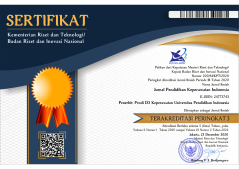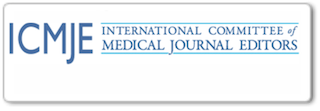Tingkat Kepuasaan Mahasiswa DIII Keperawatan Dalam Pembelajaran Klinik
Abstract
ABSTRAK
Dalam dekade terakhir berbagai kajian dilakukan untuk menemukan metode pembelajaran terbaik antara preseptor, mentor dan siswa dalam pembelajaran klinik. Hal ini dikarenakan yang metode pembelajaran yang tepat dapat meningkatkan pencapaian kompetensi mahasiswa dan akan berpengaruh terhadap tingkat kepuasan mahasiswa. Salah satu metode pembelajaran klinik yang sering diterapkan dalam pembelajaran klinik adalah metode Preceptorsip, namun belum diketahui bagaimana kepuasaan mahasiswa terhdap metode tersebut. Tujuan penelitian ini adalah untuk mengetahui tingkat kepuasaan mahasiswa DIII Keperawatan dalam pembelajaran klinik. Desain penelitian adalah deskriptif kuantitatif. Instrumen menggunakan kuesioner yang disusun berdasarkan teori Service Quality. Jumlah sampel adalah 93 mahasiswa, dengan teknik Purposive random sampling. Hasil penelitian menunjukan tingkat kepuasan mahasiswa adalah 49 responden (52,7%) puas dan 44 responden (47,3%) menyatakan tidak puas. Pada dimensi tangible 54,8% menyatakan puas, dimensi reliability 62,4% menyatakan puas, dimensi responsiveness 66,7% menyatakan puas, dimensi assurance 74,2% puas, dan dimensi emphaty 80,6% menyatakan puas. Kepuasan mahasiswa behubungan dengan sikap, kesungguhan mereka saat menjalankan profesi mereka. Di harapkan pihak institusi pendidikan dan rumah sakit dapat mengembangkan berbagai metode pembelajaran yang lebih memperhatikan berbagai dimensi dalam kepuasaan pembelajaran klinik.
ABSTRACT
In the last decade, various studies have been carried out to find the best learning methods between preceptors, mentors, and students in clinical learning. This is because the right learning method can increase the achievement of student competencies and will affect the level of student satisfaction. One of the clinical learning methods that are often applied in clinical learning is the Preceptorsip method, but it is not yet known how student satisfaction with that method. The purpose of this study was to determine the level of satisfaction of Nursing DIII students in clinical learning. The research design is quantitative descriptive. The instrument uses a questionnaire prepared based on Service Quality theory. The number of samples was 93 students, using a purposive random sampling technique. The results showed the level of student satisfaction was 49 respondents (52.7%) satisfied and 44 respondents (47.3%) expressed dissatisfaction. On tangible dimension 54.8% expressed satisfaction, reliability dimension 62.4% expressed satisfaction, responsiveness dimension 66.7% expressed satisfaction, assurance dimension 74.2% satisfied, and empathy dimension 80.6% expressed satisfaction. Student satisfaction is related to their attitude, sincerity when carrying out their profession. It is hoped that educational institutions and hospitals can develop various learning methods that pay more attention to various dimensions in clinical learning satisfaction.
Keywords
Full Text:
PDFReferences
Abreu, W.C. & Interpelar, S.S. (2015). Effective Mentorship to Improve Clinical Decision Making and a Positive Identity: A Comparative Study in Turkey and Portugal. International Journal of Information and Education Technology. Vol. 5(1):42-45
Agustini, N. M., & Agustini, N. M. (2016). Hubungan Peran Pembimbing Klinik Dengan Kepuasan Mahasiswa Dalam Praktek Lapangan Klinik Keperawatan Di Irna C Rsup Sanglah Denpasar Tahun 2015
Aritonang R. (2005). Kepuasan pelanggan, pengukuran dan penganalisaan dengan SPSS. Jakarta: Gramedia Pustaka Utama Asmara, F. Y. (2012). Implementation of Mentorship Preceptorship Method in Internship Nursing Students Nursing School Diponegoro University.
Astuti, V. W., Kusumawati, W., & Pembimbing Klinik Dalam Proses Pembelajaran Di Klinik. Jurnal Penelitian Keperawatan, 2(2). Depkes RI. (2009). Sistem Kesehatan Nasional. [Online]. Diakses dari http://www.depkes.go.id
Dermawaan. Deden (2012), Mentorship Dan Perceptorship Dalam Keperawatan, Jurnal Akper Poltekkes Bhakti Mulia Sukoharjo
Fikri. (2001). Faktor-faktor yang Mempengaruhi Pelaksanaan Asuhan Keperawatan di IRD RSU dr Sarjito. UGM : Yogyakarta.
Firmansyah, R., & Kristina, T. N. (2012).Faktor-Faktor yang Mempengaruhi Kepuasan Mahasiswa Kedokteran Terhadap Pelatihan Keterampilan Klinik Di Tahap Sarjana
Gunarsa,Singgih.(2008).PsikologiPerawatan. Jakarta: Gunung Mulia
Hidayat, A. 2007. Riset keperawatan dan tehnik penulisan ilmiah. Jakarta: Salemba medika
Hindawi. (2012). Preceptorship and Mentorship. https://www.hindawi.com/journals/nrp/si/389707/cfp/
Hsu, Li-Ling, Hsieh, Shuh-Ing, Chiu, Hsiu- Win, & Chen, Ya-Lin. (2014). Clinical Teaching Competence Inventory for Nursing Preceptors: Insrumental Development and Testing. Journal Contemporary Nurse, Vol.
(2), 214-224
Irwin, C., Bliss, J., & Poole, K. (2018). Does Preceptorship improve confidence and competence in Newly Qualified Nurses: A systematic literature review. Nurse Education Today, 60, 35–46. https://doi.org/10.1016/j.nedt.2017.09.011
Omer, T. Y., Suliman, W. A., Thomas, L., & Joseph, J. (2013). Perception of nursing students to two models of preceptorship in clinical training. Nurse Education in Practice, 13(3), 155–160. https://doi.org/10.1016/j.nepr.2013.02.003
Quek, G. J. H., Ho, G. H. L., Hassan, N. B., Quek, S. E. H., & Shorey, S. (2019). Perceptions of preceptorship among newly graduated nurses and preceptors: A descriptive qualitative study. Nurse Education in Practice, 37(May), 62–67. https://doi.org/10.1016/j.nepr.2019.05.001
Roberts, M. E., Wheeler, K. J., Tyler, D. O., & Padden, D. L. (2017). Precepting nurse practitioner students: A new view—Results of two national surveys of nurse practitioner preceptors. Journal of the American Association of Nurse Practitioners, 29(8), 484–491. https://doi.org/10.1002/2327-6924.12482.
Hamzah, N. N., Putri, S. T., & Sumartini, S. (2019). The Experience of Nursing Students in the Clinical Learning Using Peer Learning Method. Jurnal Keperawatan Soedirman, 14(1), 23-30.
Teferra, A. A., & Mengistu, D. (2017). Knowledge and attitude towards nursing clinical preceptorship among Ethiopian nurse educators: An institution-based cross-sectional study. International Journal of Africa Nursing Sciences, 7(October), 82–88. https://doi.org/10.1016/j.ijans.2017.10.001
Junaedi, D. (2018). Evaluasi Kualitas Pelayanan Jasa Kepariwisataan dengan Metode SERVQUAL dan QFD.
Mahanani, Srinalesti (2014). Analisis Kinerja Perawat Pembimbing Klinik Dengan Pendekatan Teori Kinerja Dan Indikator The Competence Of Nurse Educators.
Mukarromah, N. (2016). Hubungan Kompetensi perceptor dalam pelaksanaan program perceptorship dengan self efficacy ners muda dalam memberikan asuhan keperawatan pada pasien. Health Sciences,
Nursalam, Effendi. (2013). Pendidikan Dalam Keperawatan. Jakarta: Salemba Medika.
Nursalam. (2011). Konsep dan penerapan metodologi penelitian ilmu keperawatan. Jakarta : Salemba Medika
Omer, T. Y., Suliman, W. A., Thomas, L., & Joseph, J. (2013). Perception of nursing students to two models of Preceptorship in clinical training. Nurse education in practice, 13(3), 155-160.
Oroh, M. E., Rompas, S., & Pondaag, L.(2014). Faktor-Faktor Yang Berhubungan Dengan Tingkat Kepuasan Pasien Rawat Inap Terhadap Pelayanan Keperawatan Di Ruang Interna RSUD Noongan.
DOI: https://doi.org/10.17509/jpki.v5i2.18076
Refbacks
- There are currently no refbacks.
Jurnal Pendidikan Keperawatan Indonesia(JPKI) published by Indonesia University of Education. JPKI is licensed under a Creative Commons Attribution-ShareAlike 4.0 International License.
Office :
Nursing Department. FPOK UPI.
229, Dr. Setiabudhi Street. Bandung 40154
West Java , Indonesia
E-mail : jpki@upi.edu

_.png)
_.png)
_.png)











